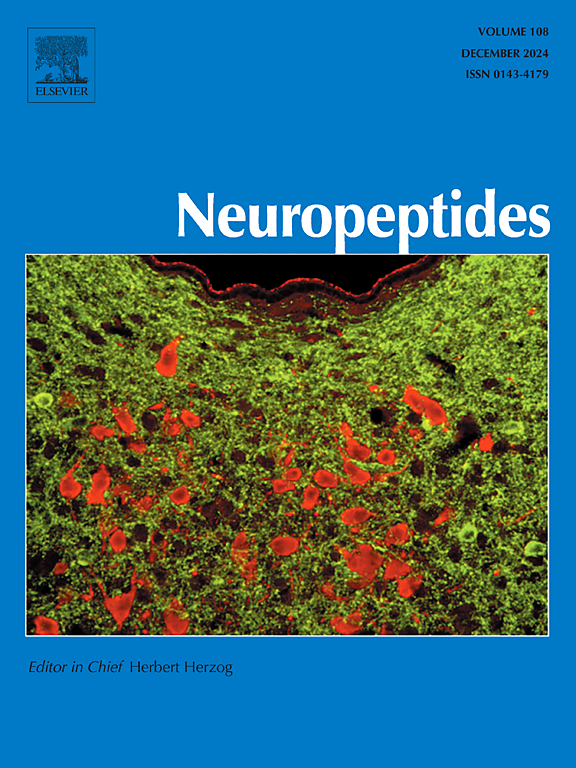Molecular mechanisms of GDNF/GFRA1/RET and PI3K/AKT/ERK signaling interplay in neuroprotection: Therapeutic strategies for treating neurological disorders
IF 2.7
3区 医学
Q3 ENDOCRINOLOGY & METABOLISM
引用次数: 0
Abstract
Neurological disorders, marked by progressive neuronal degeneration, impair essential cognitive functions like memory and motor coordination… This manuscript explores the significant roles of glial cell line-derived neurotrophic factor (GDNF), its co-receptors (GFRA1), and the receptor tyrosine kinase (RET) in mediating neuronal survival and function in various neurodegenerative conditions. The interplay between pivotal signaling pathways—PI3K/AKT and ERK1/2—facilitated by GDNF/GFRA1/RET, is emphasized for its neuroprotective effects. Dysregulation of these pathways is implicated in neurodegenerative and neuropsychiatric processes, with overactivation of GSK3β contributing to neuronal damage and apoptosis. Experimental evidence supports that activation of the RET receptor by GDNF enhances AKT signaling, promoting cell survival by inhibiting apoptotic pathways—therapeutic strategies incorporating GDNF delivery and RET activation present promising neuronal protection and regeneration options. Furthermore, inhibition of GSK3β demonstrates potential in ameliorating tau-related pathologies, while small molecule RET agonists may enhance therapeutic efficacy. This review explores the knowledge of GDNF/GFRA1/RET and PI3K/AKT/ERK1/2 associated signaling cascades, underscoring their significance in neuroprotection and therapeutic targeting to combat neurodegenerative diseases. Emerging approaches such as gene therapy and small-molecule RET agonists may offer novel avenues for treatment, although challenges like targeted delivery across the blood-brain barrier remain pertinent.
GDNF/GFRA1/RET和PI3K/AKT/ERK信号相互作用在神经保护中的分子机制:治疗神经系统疾病的治疗策略
神经系统疾病,以进行性神经元变性为特征,损害了基本的认知功能,如记忆和运动协调…本文探讨了神经胶质细胞系来源的神经营养因子(GDNF),其共受体(GFRA1)和受体酪氨酸激酶(RET)在各种神经退行性疾病中介导神经元存活和功能的重要作用。GDNF/GFRA1/RET促进的关键信号通路pi3k /AKT和erk1 /2之间的相互作用强调了其神经保护作用。这些通路的失调与神经退行性和神经精神过程有关,GSK3β的过度激活有助于神经元损伤和凋亡。实验证据支持GDNF激活RET受体增强AKT信号,通过抑制凋亡途径促进细胞存活——结合GDNF和RET激活的治疗策略提供了有希望的神经元保护和再生选择。此外,抑制GSK3β显示出改善tau相关病理的潜力,而小分子RET激动剂可能增强治疗效果。本文综述了GDNF/GFRA1/RET和PI3K/AKT/ERK1/2相关信号级联的相关知识,强调了它们在神经保护和靶向治疗神经退行性疾病中的重要意义。诸如基因疗法和小分子RET激动剂等新兴方法可能为治疗提供新的途径,尽管诸如通过血脑屏障靶向递送等挑战仍然相关。
本文章由计算机程序翻译,如有差异,请以英文原文为准。
求助全文
约1分钟内获得全文
求助全文
来源期刊

Neuropeptides
医学-内分泌学与代谢
CiteScore
5.40
自引率
6.90%
发文量
55
审稿时长
>12 weeks
期刊介绍:
The aim of Neuropeptides is the rapid publication of original research and review articles, dealing with the structure, distribution, actions and functions of peptides in the central and peripheral nervous systems. The explosion of research activity in this field has led to the identification of numerous naturally occurring endogenous peptides which act as neurotransmitters, neuromodulators, or trophic factors, to mediate nervous system functions. Increasing numbers of non-peptide ligands of neuropeptide receptors have been developed, which act as agonists or antagonists in peptidergic systems.
The journal provides a unique opportunity of integrating the many disciplines involved in all neuropeptide research. The journal publishes articles on all aspects of the neuropeptide field, with particular emphasis on gene regulation of peptide expression, peptide receptor subtypes, transgenic and knockout mice with mutations in genes for neuropeptides and peptide receptors, neuroanatomy, physiology, behaviour, neurotrophic factors, preclinical drug evaluation, clinical studies, and clinical trials.
 求助内容:
求助内容: 应助结果提醒方式:
应助结果提醒方式:


